Baranof Blog & Fishing News
- Home
- Baranof News Blog
IPHC Fixes 2024 Guided Halibut Harvest Measures
The International Pacific Halibut Commission’s (IPHC) wrapped up its annual meeting this week in Anchorage setting stock-wide and area specific regulations for the Pacific halibut fishery. The Commission took another round of cuts in Catch Limits for 2024 citing low stock levels and uncertainty in environmental factors and recent recruitment.
Guided Angler Limits for the 2024 season:
Area 2C
- Daily bag limit of one halibut
- Max lower size limit of 40” through July 14th
- Max lower size limit of 36” on or after July 15th
- An upper limit fixed at 80” or greater all season
- Fridays closed to halibut retention between July 19th- September 13th
- Guided Angler Fish (GAF) halibut retention allowed on closed days
- No angler may exceed the recreational limit of two halibut per day per angler
Area 3A
- Daily bag limit of two halibut
- One halibut of any size and a second fish no greater than 28”
- All Wednesdays closed
- One trip per charter vessel per day
*Always check the officially posted regulations before going fishing.
SEAGO’s executive director Forrest Braden sits on both the IPHC’s Management Strategy Advisory Board (MSAB) and Conference Board (CB). Braden attended this week’s meeting working with longline and charter representatives from across the state as well as IPHC staff and leadership to arrive at recommendations for coastwide removals and regulatory area allocations favorable to Southeast Alaska.
Braden argued that although the halibut stock is at a low level, the cuts being considered would harm Southeast fisheries while not providing a meaningful benefit to stock increase which relies largely on good recruitment events. “It’s a waiting game.” Braden said. “The stock is not overfished or below any critical levels. We just need to make reasonable choices in removals that keep it that way while supporting the harvest needs of fisheries while we wait for some good year classes to enter the fishery.”
SEAGO would like to thank all those who wrote public comments to support the work Braden was doing in person offering the IPHC Commissioners the perspective of industry members when it comes to the challenges we face on limited, and lowering, halibut allocations. Nine of the fifteen stake holder written comments provided to the IPHC Board for this meeting came from Southeast sport representation. A clear majority. Showing Southeast Alaska is involved in this process and invested in the outcomes. A large thank you for all those who contributed!
We appreciate those who attended SEAGO’s Halibut Training meeting in January where industry members were trained on how allocation is decided, history of the halibut fishery, and how to get involved in the process. It is the position of SEAGO that as we band together, become educated, and advocate for our businesses and way of life we will be able to impact long-term sustainable policies that will support the gold standard of fishing that Southeast is known and loved for.
Stay tuned for an exciting upcoming announcement on the NEW SEAGO membership model, benefits package, and how you can get more involved.
King salmon 1 King Salmon per person, 28 inches in length or longer.
- January 1 through June 30: Nonresident annual limit is three king salmon.
- July 1 through July 15, Nonresident annual harvest limit is two king salmon, 28 inches or greater in length.
- July 16 through December 31, Nonresident annual harvest limit is one king salmon, 28 inches or greater in length.
Coho, Chum, Pink and Sockeye salmon 16 inches or longer: 6 of each species per day 12, of each species in possession
Coho, Chum, Pink and Sockeye salmon(in combination) less than 16 inches: 10 per day, 10 in possession.
Lingcod 1 per day, 1 in possession; 30-35 inches or 55 inches and longer, annual limit of 2 fish, one of which is 30-35 inches in length, and one that is 55 inches or greater in length. A harvest record is required.
Halibut 1 per person per day, less than or equal to 40 inches or greater than or equal to 80 inches.
Monday closures. Charter vessel anglers may not catch and retain halibut on all Mondays beginning July 24, 2023 continuing until December 31, 2023.
We have news for our 2022-fishing season. The International Pacific Halibut Commission (IPHC) has just announced the slot limit is 40’ or less for the entire 2022 season, allowing anglers to keep one halibut under 40 inches or over 80 inches each day. The time is now to start planning your fishing trip!
The "Alaska wilderness dining" tours are dear to my heart for a number of reasons, the first being, it is how Baranof fishing was born... and that tour allows some latitude at times to vary the sequence of experiences before going to the camp to partake of a wonderful meal in a beautiful setting by a warm fire...
For instance, one charter I had on June 11th, 2017, was with two nice families on their first trip to the Ketchikan area; we were able to find some beautiful quillback rockfish in a fairly quick amount of time that was sufficient to feed everyone on board, so I presented them with some options: we could use the remaining time before the meal to do some wildlife viewing and try to do some trolling for king salmon if they were so inclined...the first opportunity was the seal haul-out in the middle of the blank inlet, and we cruised the shoreline to possibly spot a black bear or deer on the beach, which took us in the amount of time needed for the current and state of the tide to be at its changing point... the prime time of tide, perfect part of the season, and we were next to the camp channel where I have caught many king salmon with and without clients...
I rigged the baits and dropped them on the downriggers to the depths I felt best, one of them being 15 feet from the bottom, a whole herring on a slow roll; we trolled about 50 feet when the bait pulled out of the clip on that side, and as the client pulled back on the rod, it bent towards a line coming to the surface at a fair distance from the boat!
A King salmon! Confirmed by the tail and dorsal breaking the surface as it strained at the line, with the client holding steady pressure and keeping the line taut, the beautiful fish was netted within a few minutes and brought on board to the wonder and joy of those who had never caught one, a privilege to behold and participate in... then we did it again, within a few minutes of boating the first one, I had the lines back in and we hooked another King salmon within 100 feet of the first!
Another good fight and netted some pictures and then it was time for the camp meal; they don't always include fresh filet of King salmon, but it can happen, and this time it did... An amazing day with wonderful people in a beautiful setting...
We have big news for our 2021-fishing season: they have increased the size limit on the halibut you’re allowed to keep! The International Pacific Halibut Commission (IPHC) has just announced the lower slot limit will now be increased to 50 inches for the entire 2021 season, allowing anglers to keep one halibut under 50 inches or over 72 inches each day. This is quite a significant jump from 2019s regulations of 38 inches, approximately 25-pounds, to 50 inches, approximately 60-pounds, allowing guests to keep halibut up to 35-pounds heavier! The time is now to start planning your fishing trip!
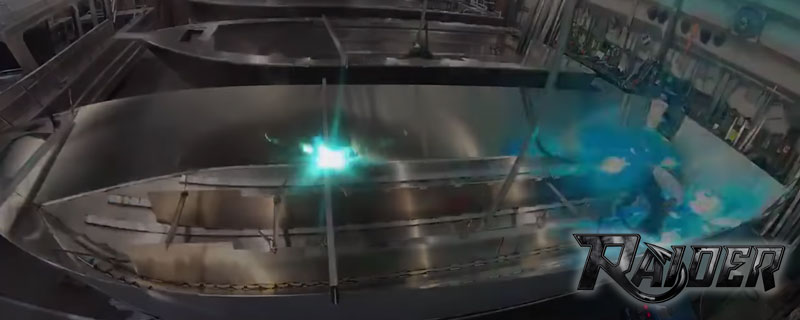
Raider’s 30’ cabin cruisers allow us to fish Southeast Alaska in style. With a heated cabin, private head and the length and beam to offer a smooth ride even in inclement weather, this vessel is the obvious choice when comfort is paramount. Their dual 225-hp Hondas provide the speed necessary to run to the Misty Fjords or distant fishing hotspots efficiently. With a heated cabin, whatever the weather, the whole family will be comfortable for the duration of their time on the Alaskan waters. Boasting a private head, stopping at a wilderness beach to answer the call of nature is still an option, but no longer a necessity.
The combination of speed, fishing capabilities and luxury that this vessel affords our private charter guests enables us to create custom excursions for even the most discerning of clients. A private exploration of the Misty Fjords, followed by world-class bottom or salmon fishing and a 5-star Cook Your Catch meal in our private dining room featuring the fish, crab and shrimp you caught yourself is exactly what this boat was designed for. We operate 24 different Raiders (7 skiffs, 15 Coastals, and two 30’s). We’ve tried other brands over the years, but the 30’ Raider fits Baranof’s vision of an authentic Alaskan experience like no other.
Check out our friends at Raider Aluminum Boats here. [https://www.raiderboats.com/]
UnstoppableWe’re Unstoppable... Check out this quick build on this custom 30’ Offshore for our friends in Homer Alaska. With Central Charters #RaiderBoats #Offshore #Homer #HomerSpit #Halibut #Charter #SuzukiMarine #Aluminum #Fabrication #Welding #MillerWelds #Boat #BoatBuilding
Posted by Raider Boats on Wednesday, March 25, 2020
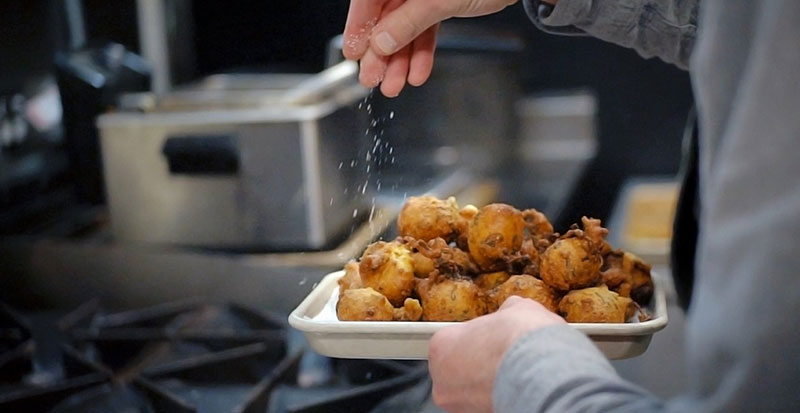
After getting word of a seaweed conference happening in Ketchikan, we got excited to invite the attendees to the Fish House to help us tell the story of edible seaweed so we could better educate our team, the community, and our fishing and restaurant guests. We were able to get some incredible video content interviewing some of the experts from the conference who are at the forefront of edible seaweed and aquatic farming.
My focus for this coming season, as well as the future of our culinary program, is to showcase underutilized species and make an incredible meal with them. Seaweed plays an important role in traditional foods of the Southeast, sustainable mariculture and the potential for economical growth in Ketchikan.
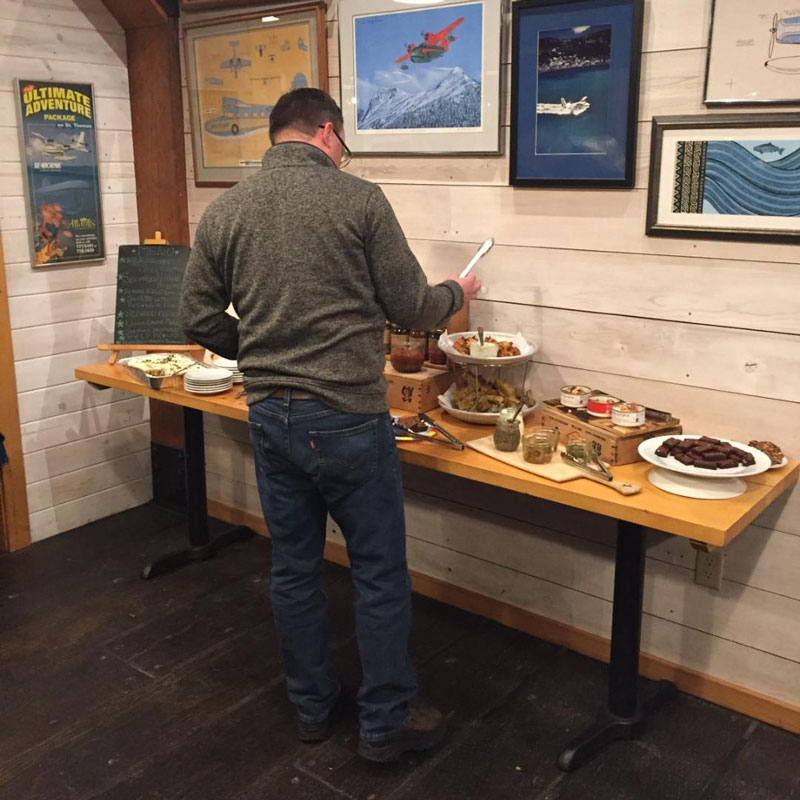
I have used edible seaweeds for cooking, but it has never been at the forefront of a menu or specific dish. This was a unique opportunity for me to create a menu making seaweed the star and reflect on my first-time harvesting seaweed. My first full day in Alaska when I arrived three seasons ago, I was taken out by one of our guides along with other members of our team and a local native on a trip to harvest seaweed. Our native expert watched from the deck of the boat with binoculars in search of black seaweed. The hunt was on as we planned our exit from the boat waiting for the right time in between swells. Outfitted with spiked logging footwear and a pillowcase, after a few attempts we jumped off the bow onto a remote exposed rock in the middle of the ocean. The boat took off and as I watched it leave, I wondered to myself if anyone had ever stepped foot on this rock before.
It was just the local native and me and he immediately started to show me everything edible that the rock had to offer. From gumboots, slippers to sea urchins, and the black seaweed that we were there to harvest. After snacking on some strange and tasty treats from within the tide pools, we began to fill our pillowcases with the prized black seaweed. I was enjoying myself immensely but still had not realized the importance of the seaweed and how it would transform dishes that I would be preparing throughout the season. Once we were back at our marina, we started the drying process of the seaweed to preserve it for the months to come. Little did I know that seaweed would become a part of my culinary adventures here in Ketchikan.
The menu I chose last Monday included local dried black seaweed, fresh kombu, and wakame. I also partnered with Foraged & Found who produce local retail products with kelp. I was able to showcase some of their kelp salsas and pickles, but I also used the pickled kelp in some of the recipes as well. Some of the highlights of the menu were Kombu hush puppies with pickled kelp remoulade, a smoked seafood display accompanied by seaweed mustard, lemon crème Fraiche, seaweed focaccia as well as wakame and kombu brownies.
We made some new friends within the seaweed world and we are excited to start sharing our knowledge that we acquired about the 7 common seaweed species available to us in Ketchikan. More to come throughout the season with seaweed recipes, blogs, and videos to showcase this underutilized ingredient whose story will continue to be told with hopes of becoming an economic engine for our community.
From our chef, Austin Green
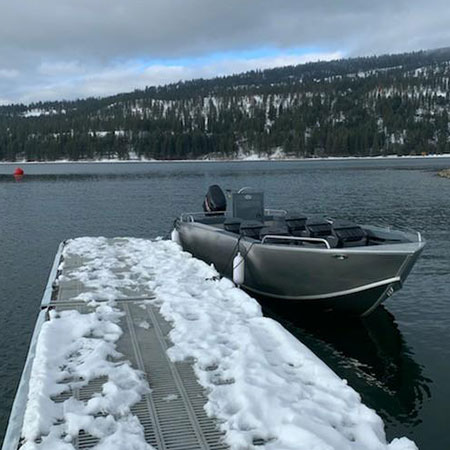
Nonpelagic rockfish will no longer be available for retention in the 2020 season. For the last 19 years, these fish have been a reliable target species for our Wilderness Dining guests, as well as a welcome addition to the table during our Cook Your Catch excursions. We’re addressing this closure by expanding our abilities to target any of the other 50-odd species that we can reliably target on a given day. One key enhancement will be our improved electronics package that will enable our captains to find schools of salmon and pelagic rockfish, with another being the introduction of our autopilot and trolling motor capabilities.
Garmin has really become the leader in sportfishing electronics, and our boats are outfitted with the best of the best that Garmin has to offer our class. The navigation displays are 1042xsv series GPS maps units that not only allow for pinpoint accuracy in boat-to-bottom navigation, it also allows for an amazing 1000 watts of power to be fed to the boat’s state-of-the-art sonar sounders and Panoptix setup. We’ll be utilizing Garmins GT54UHD sounder that provides for a low-frequency chirp to really paint the bottom of the ocean floor along with an ultra-high frequency chirp sounder that auto-adjusts from 800 to 1200 kHz. This allows you to not only see fish swimming at depth but in so much detail that you can actually see kelp forests sway with the current, see your bait descending to the bottom and even the fish coming out to bite on what customers have placed in front of the fish. Truly amazing sonar ability.
Next on the list of new upgrades is the new Panoptix live scope technology. This is a sonar system that really leaves little to the imagination of what is below your boat. This live scope system uses three independent sonar scanners to produce a 3D image of what is swimming below. In real-time imagery that shows you the fish’s depth, distance, and direction in relation to the boat. Pelagic rockfish, lingcod, and salmon will be painted across the screen with their location data so the guide can assist customers in not only knowing where to drop but how deep to drop the line. It’s like having your own personal diver with an underwater camera filing to your fish finder’s display.
Both the skiffs and our hardtop Coastals will be equipped with GPS controlled autopilots. Our skiffs are using a 36-volt electric trolling motor that has a GPS spot lock function which allows the captain to lock the boat within a 3ft radius of a GPS location. This allows the captain to target specific species without the need to anchor or drift. Along with the ability to GPS anchor lock, the boat will have the ability to run a trolling route for targeting salmon or other pelagic species hands-free. The trolling motor will allow captains to spend less time on the tiller and more time getting fish onboard. Our hardtop Coastals are getting their own version of this same type of autopilot. Rather than a trolling motor mounted on the bow, however, the larger vessels will be utilizing their kicker motor which is networked into the 1042xsv nav unit to hold a course heading, back troll an area, or hover over a group of pelagic fish.

2019 was a tremendous year for us as we hit new highs in customer satisfaction in the restaurant and on the water. Using this momentum, we’re making some improvements to our culinary offerings as well as the fishing fleet.
New skiffs!
The most noticeable change any of our repeat customers will notice is that we’re upgrading our 5-passenger open-air skiffs to a completely new design better suited for light-tackle fishing. These new boats are a couple of feet longer, console driven rather than a tiller, will be equipped with a 115 h.p. motor, include an upgraded electronics package, can seat 6 passengers and feature a trolling motor that will “anchor” the boat anywhere through GPS integration. Construction has begun on seven of these new vessels for 2020, so we’ll be getting photos out as soon as we get a couple in the water this spring.
Seafood Invitational
Cook Your Catch, whether in our private dining room or at our wilderness campsite, is our passion. Most of our guests that come up for more than a cruise ship calls have already had a taste of our multi-day fishing/dining options, but this year we’re taking it a step further. We’re telling the comprehensive story of Alaskan seafood over the course of five choreographed meals featuring twenty-five unique species. Check out our invitation here for dates as well as a complete description, it’s going to be quite the production.
Merry Christmas, happy holidays, and a blessed New Year from the Alaska Fish House and Baranof Fishing crew. We look forward to seeing our friends, old and new, during the upcoming season.
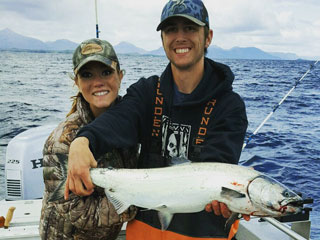 The day this story takes place started out like many in southeast Alaska - rainy and windy. Even though it was mid-July, when the weather is generally more agreeable for fishing, this day was an exception. It was blowing hard enough that I didn't even venture past Bold island, which is generally only a mid-way point to our halibut and salmon grounds. This was especially frustrating because I was fishing with two gentlemen who have been guests on my boat for the past three years. I look forward to them coming up each year and enjoy their company when they are here.
The day this story takes place started out like many in southeast Alaska - rainy and windy. Even though it was mid-July, when the weather is generally more agreeable for fishing, this day was an exception. It was blowing hard enough that I didn't even venture past Bold island, which is generally only a mid-way point to our halibut and salmon grounds. This was especially frustrating because I was fishing with two gentlemen who have been guests on my boat for the past three years. I look forward to them coming up each year and enjoy their company when they are here.
I knew the halibut fishing options were limited, so after a talk with the guys, we opted to fish for salmon since the pinks and silvers were fairly thick and were making showings close to town. The salmon bite had been pretty vicious till about 8 A.M. in the days prior, so I had high hopes that we would whack a few before the bite slowed. On this particular morning, the bite was spotty at best. We would hit pockets of fish and land one or two, then double back only to not get a bite, let alone a takedown. On top of this, the driving rain and howling wind made it difficult for all parties involved to land the fish we were hooking (this wasn't looking good).
As the morning progressed, we spent more time catching up with each other than high-fiving and catching fish. All the while the wind was twisting our arm and driving us closer towards town looking for better protection from the weather. During the final hour of the trip, I made the call to make our last few passes at Mountain Point (a popular but productive spot about six miles from our dock). Almost as soon as we started our drag, the down rod blew out of the clip and started taking line - fish on!
I call for my friend to "grab the rod!" - he pulls it out of the holder and starts his fight. It fights like a nice silver and I cross my fingers we can land this one to end the day on a high note. The fish appears on the surface forty yards behind the boat, jumping and tail-walking like a tarpon you would see on T.V. We all have our eyes on the coho, but unbeknownst to me, we are not the only ones watching its big show. As we start gaining line on the fish I catch sight of what looks to be a brown and white tomahawk missile coming out of the sky. In about half a second we all put together what's happening; a bald eagle that had been perched off of the Point had targeted our fish. He hits the water fast and clips the fish, sending it into a frenzy straight toward the boat. It's all we can do to keep up on retrieving the line and putting tension back on the fish. In no time flat, the fish has reached the boat. I grab my net and get ready to attempt to scoop the very green silver when all of a sudden another missile screams by us! The bird is back and he means business - no more than six feet off the starboard side, swooping at the fish, gaining altitude and attempting again. All the while the fish is on the edge of spitting distance and out of net range. Now we make a decision - we need to "horse" this thing to the boat or we are going to have a serious mess on our hands. We leverage the rod and ski the fish within the net range. I dip my net in the water just as a simultaneous eagle attack occurs. The fish goes into another frenzy, this time wrapping itself around the downrigger cable several times. I take one more dip at him but I know what's about to happen… I can't get deep enough to reach the fish and he is wearing the mainline out on the wire cable! The line snaps and the fish rockets off, the bird flies away, and in the ensuing quiet all we can do is look at each other with expressions that say; "We just can't get a break, can we?”.
We end the wet and windy day without landing another keeper but return to the marina with one of the most eventful salmon fishing stories any of us have ever heard. Fishing is a game of anticipation, artistry, and passion. Catching an elusive species, landing a trophy-size monster, dropping a fly perfectly into a river’s eddy or competing with another apex predator for the same fish all amount to the same thing – living a once-in-a-lifetime experience. On the worst of days, we accomplished exactly that. After tying up and shedding our raingear, we went to the restaurant where chef Austin cooked up some of the fish we had caught earlier in the morning. My clients and I capped off their fishing vacation with a 5-star meal, while our conversation focused on the highlight of their vacation - we all agreed that the “mottled missile” made the day.
Until next year guys!
Captain Ramirez

The doors have been closed for the last time in 2019, and everyone can breathe again. For the Alaska Fish House servers, cooks, managers and support staff, this was an incredible season. More people than ever before came off the cruise ships and dined at the Fish House, which is great, but what’s truly remarkable is that despite a marked increase in business, our TripAdvisor review rating increased dramatically. With no change to the infrastructure, the only possible explanation is the staff – thank you all for your attention to detail and hard work.
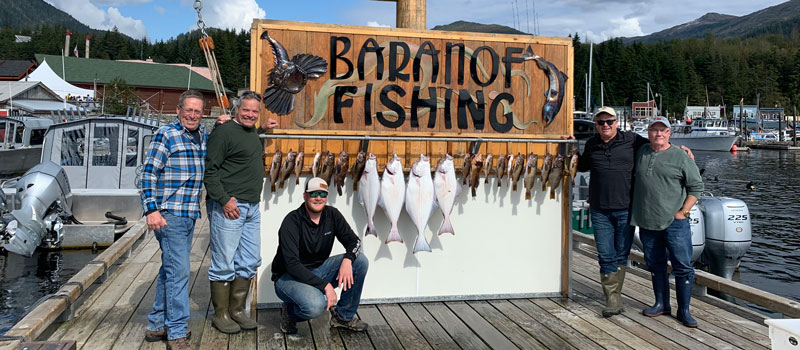
2019 was Baranof’s most successful season to date by most metrics, but most importantly when measured in terms of customer and employee satisfaction. Those of us working behind the scenes that don’t get a lot of time with the customers rely on the guides and tour ops to represent us - this year more than ever we’re proud to be part of a winning team.
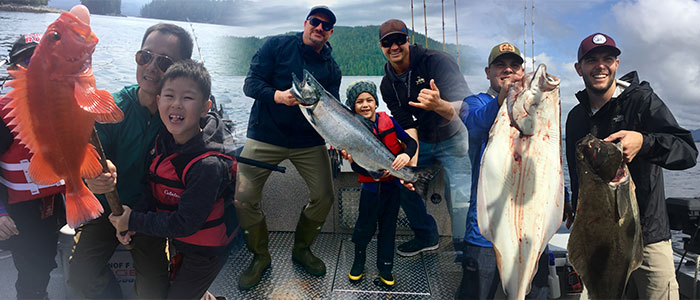
Halibut: Halibut fishing around Ketchikan has been consistent the past couple months with most of our halibut charters yielding limits or close to it - with the exception of large negative tide days the success rate has been high. The weather has been consistently nice with more days than not being sunny and warm. The water is sitting at its usual sixty-degree surface temperature, on par for this time of year. If the fishing continues on this trajectory we should see good halibut fishing sustained at least through mid-September.
Bottomfish: Lingcod is open, and for the educated angler they provide an excellent fight and a pile of good meals. Rockfish and pacific cod seem to be around in numbers and are a nice addition to a fish box.
Salmon: The pink and silver salmon have arrived in Ketchikan and have been accepted with open arms. The pinks especially have shown a strong return and the fishing has been as good as ever. Pinks are great fighters and excellent table fare when taken care of properly. Silvers have been a little more inconsistent but are being found, albeit usually farther out then the hordes of pinks. King salmon are closed for retention since August 1st, but we enjoyed some of the better King salmon fishing Baranof has seen in the past few years. Some Kings are still being caught but will have to be released for the remainder of the season.
We expect the good fishing to continue through the end of the season, and as long as the weather is kind to us we will be able to get our guests out to the most consistent and productive fishing grounds around Ketchikan. Midseason Captain's Report

Overall, it being May and still before the great migration started, Baranof Fishing got it done.
Halibut -
Sunny days and clear skies were great for getting a Southeast Alaskan tan, but for the guides it was a bit of a tough one; success rates were high, it just took some extra work. The water temperatures were a few degrees above normal, with readings being in the high 40s – mid 50s. With a little extra effort fueled by a winter of not fishing and some friendly competition amongst the guides, our clients enjoyed a higher success rate than we normally experience during the month which resulted in most of our clients hooking up to their once-in-a-lifetime halibut (we did have some king salmon success, but until June 1st it was catch and release). Since the weather was atypical in its sunny brilliance, we were able to run farther out when our normal fishing grounds didn’t prove successful. As the it got later in the month, more and more halibut started to show up as their migration brought them in from their winter spawning grounds to their summer feeding locales surrounding Ketchikan. Guests that did get a halibut on the boat may have noticed red marks on their fish’s belly; those “bruises” come from their being on the move as they travel in to start their feeding. They’re here and they’re getting fattened up for the season; we’re looking forward to continued success throughout the summer.
Salmon -
June 1st brought the anxiously awaited opening of king salmon fishing. Trolling around and hooking up to a king is the pinnacle of Ketchikan angling for some, and we’ve been doing great. Despite the concern for the salmon population, the fishing is good. In a few more weeks we will be seeing the first signs of coho and pink in the area to round out a full day of salmon fishing.
Whales -
As we’ve navigated through the waters in the area we’ve noticed the “boiling” areas of water that indicate a disturbance on the surface caused by the feed-fish. With seagulls and eagles dive bombing the water, you know for sure that there is going to be herring or other small fish around. Herring means salmon, and salmon means whales! The herring have arrived and so have the humpbacks; we’ve seen the whales chasing herring to the surface and bubble feeding as close as Mountain Point, just on the edge of town. The king salmon moving through have the orcas hanging out as well.
The fish have arrived, and we expect the excellent fishing to continue as the season progresses. Tight lines and fish on!!!
- Captain Tony Moucha

DAY FOUR: A paddle through Rudyerd Bay
Rudyerd Bay is pretty well protected from the winds, making it an ideal body of water to kayak. Our fourth day is the day I remember the most. We left the cove and headed up Rudyerd Bay at low tide and found this amazing beach a mile or so up the bay. The group decided to stop for lunch and laying in the warm sun on the beach. After a few hours, the weather was starting to change and we knew rain was coming. We all decided to head back to camp. The group, for some reason, was in a rush to take-off (I found out later this was a planned departure). As I stood by our kayak watching our friends paddle off, wondering why the hell they were trying to ditch us, I see my partner walk across the beach towards the boats. I, of course (impatient as I am), started to get gruff and stated we need to get going to catch up with the group when I then noticed my partner on a knee with a ring. This was the day of my engagement, and now I forever have to tell that I was ornery and cranky yet still got proposed too.
That night sitting around the campfire reminiscing of the past few days it was the last night of our adventure in the Mistys. The next afternoon we would be picked up and head back to our working lives. This was the night, also, when we discovered why the Misty’s got its name. Once the clouds came in there was an only a slight sun ray beaming through the mist. It was a day, and an evening, to remember.
FINAL DAY: Goodbye, until next time
We were all up early, but I am not sure anyone can ever be completely ready for the rain that Southeast can dish out. Let’s just say it poured all night. We all had tarps over tarps over our tents and the water still got in. We all packed up and put our gear in a dry-ish location to await our pick-up before hiking to Punchbowl lake for the day. The trail was super rough going as there was a lot of blow-down on the trail from some strong winds a few weeks prior, so we did a lot of climbing over and crawling under downed trees. It just proved the point that you can never tell what you will experience on a trip into the wild. Once at the lake, we were sitting under the shelter eating lunch when the sun came out. With the rainfall what it is in Southeast, you appreciate every ray of sunlight you get. Seeing the sun come out for the first time in the Misty Fjords National monument on the first day of engagement to my wonderful partner, however, was something truly beautiful.

DAY TWO: Kayak to Checats Springs
Today we were going to kayak to Checats Springs for a hike, and, if the Behm canal was decent enough, possibly paddle over to New Eddystone rock. The paddle to Checats definitely broke our friends into how powerful the ocean and waves can be. With a headwind and 2-3 ft chop I wasn’t sure, even in double kayaks, if we would ever make it to our destination; for every paddle stroke forward it felt like we went back 3. Finally, we made it into the cove and out of the wind. It took us some time to find the trailhead. The area had been pounded by a storm a few months prior, so there were so many downed trees it made it impossible to know where the trail was at times - especially considering none of us had been here before and cellular devices don’t work in the Misty’s. Not wanting to spend our entire day hiking, we decided we had gone far enough and returned to the beach for lunch and Sun.
As we left the cove on our way back to the cabin we noticed a pod of Dall porpoises heading through the now-glassy waters making their way towards New Eddystone. We also figured this was the perfect opportunity for us to kayak across Behm Canal for a look at The Rock. These were definitely the best conditions I have ever experienced while in the canal; the sun was out, there was no wind, and the water was glass. As we headed for the island, one of the friends started freaking out. They were not a fan of kayaking across this much open water and they hated the fact that they couldn’t see under them. We found out later the reason they were a bit distraught because they thought the Dall porpoises were orcas (“killer” whales), they were sure they were going to tip us from our kayaks and eat us. As one kayak left and headed for the cabin, the rest of us headed across Behm canal towards Eddystone. The paddle across was effortless. The boat slid through the water so gracefully. This was the moment I fell in love with Alaska. Once reaching New Eddystone we took a few hours to enjoy our lunch and hike around until the tide turned and carried us down to the cabin.

DAY THREE: The 12-mile paddle to Punchbowl
We had a slight breeze, but for the most part, the waters were fairly mild. (There’s no better way to experience the waters of Alaska and the beauty they hold than the quiet solitude of a kayak, especially the Misty Fjords. Feet away from thousand-foot vertical granite walls, and inches from the sea’s surface you can’t help but soak in the grandeur; the Misty Fjords are a must see for anyone coming to Alaska. No matter how you get there, however, any Misty trip is worth the time. Each experience is different and something truly special.) By the time we made it to Punchbowl cove everyone was pretty tired from the long paddle that day, so we all set up our tents to prepare for the night. The one thing to keep in mind when doing anything in the backcountry is that we have bears. Although I have never had a bad experience with a bear, I do my best to make sure I don’t put myself in a position where I might. Once our tents were set-up we walked around the cove to prepare our cooking and eating area and find trees to hang our food and supplies in. After dinner, we headed to our sleeping area to start a fire. There is nothing that brings people together quite like a campfire, beers, and stories in the backwoods of Alaska. The beer taste better, the fire feels warmer and the venue for your stories puts any man-made theater to shame.
TO BE CONTINUED...

My partner and I had just recently moved to Ketchikan for an adventure of a lifetime. On our 2-day ferry ride to town, we worked on our Ketchikan/Southeast Alaska bucket list. One of the top items on that list was to visit the Misty Fjords National Monument. To this point all, the sum of our experience with the Mistys was a flightseeing tour out of Ketchikan that included a brief landing on an alpine lake - or information we had read online. The pictures and history of the Ketchikan area were exciting and intriguing to us, especially New Eddystone Rock which was formed at the end of a volcanic vent where magma repeatedly rose to the surface of the earth. How amazing! I knew once I read that I had to go and see Eddystone from a viewpoint most people never get to experience.
After a short time in Ketchikan, we had found the joy of exploring the area by kayak. That is where the idea of kayaking through the Misty Fjords was born. Anyone who has been to Ketchikan / Southeast Alaska knows the hardest thing with exploring is all the logistics and planning that is required. You can’t just plan a trip for 3-days. Storms and weather can come in fast around here and, the next thing you know, your 3-days trip has turned into a week. However, that is a different story. Being new to town and not owning our boat was one of the biggest obstacles we had in the beginning. We were lucky, however, that you can find private charter boats to take you to different locations throughout Southeast…
Because we felt this was going to be an adventure of a lifetime, we invited a group of friends and their partners from Idaho to join us. This proved to be an excellent idea, though stressful. Being the most experienced of the group (which meant having an entire year of experience of living in Alaska), we were deemed as the most knowledgeable and the experienced for leading the voyage. If they only knew our knowledge only consisted of how much it rained in Southeast, I wonder if they still would have trusted us as much as they did.

DAY ONE: The Adventure Begins
The route we had chosen included a stay for a few nights at Punchbowl cove, then kayaking to Winstanley Island Cabin for the remaining two nights. To give our friends a different perspective of the adventure we were about to head out on, we decided to send them by float plane for a bird’s eye view of the area while my partner and I boated out with all of our gear and kayaks in the water taxi/private charter. Just before we were about to depart we told our friends, “NO MATTER what, if you arrive at Punchbowl and we are not there, DO NOT GET OUT OF THE PLANE. We have all of your gear and supplies. We are your life-line in the Alaskan wilderness.” This was the first broken rule.
The boat ride to the Misty’s was breathtaking; the waters were somewhat calm and the sun was coming through the clouds. Our captain was amazing, giving us local advice of where he suggested we drop our crab pots while at the cabin. The captain also wanted to show us an old petroglyph in the area and to see the new Winstanley cabin himself, so we decided to go by the cabin on our way to Punchbowl cove - a choice that ended up changing the entire trip. As we were circling the cabin and going through an area that is covered in water at high tide but dry on a really low tide, we hit a sunken log. That log destroyed the prop of the boat. Our captain, being the experienced sailor that he was, started the kicker and headed to the cabin so he could call for help. When we arrived at Winstanley, the Forest Service maintenance crew was just putting the last touches on the cabin. Lucky for us, the cabin was available two-days ahead of schedule. “Perfect! We will do our trip backward,” we decided. Now to relay that information to the rest of the group…
Our friends departed Ketchikan by floatplane an hour later. Final destination; Punchbowl Cove. This was the group’s first time in Alaska, so they had no idea what was in store for their time in the Alaskan wilderness. The only regret we have is not seeing their faces when they flew through the Misty’s. What I do know is they saw a pod of Orcas by Eddystone, which caused someone later in the adventure a little bit of a panic situation. There was so much to take in they had forgotten the one rule we had told them before we parted ways. They were so excited to look around, not realizing at the time we were stranded at the cabin with all of the gear, food, and the kayaks, they left the plane and decided to wander around and wait for us because we should be there at any moment. Thankfully, the pilot of the floatplane decided to look for us on his way back to town. He came by the cabin and we were able to flag him down. Once he landed we explained the situation and how there was no way we could make it to the group by nightfall. So, the decision was made; he would go back and pick up the group and bring them to the cabin.
Wow!! The cabin was awesome, and we were its first occupants. We moved in quickly, ready to get in our gear and head out on the water in our kayaks to drop the crab pots and show the group the petroglyphs on the wall the captain of our boat had pointed out earlier. That night the excitement of the week to come was high. The fire was perfect, the crab pots empty, but the moods were high.
TO BE CONTINUED….
Planning on fishing out of Ketchikan this year? Better know the regulations… We have our top species listed with some insight from captain Tony Moucha to give you a guide’s perspective on the coming season, along with a link to the full ADF&G regulations book. Take a minute to check it out here as you plan your Ketchikan sport fishing adventure with Baranof.
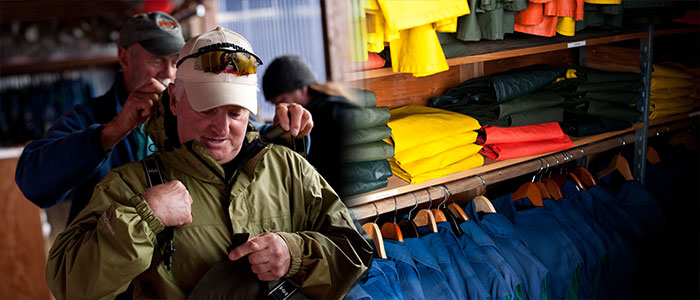
When Baranof first started, we were outfitting our guests out of the back of a canopied truck. I spent a half-hour each departure rummaging through stacks of boots, raingear, gloves, etc. as we decked out our guests. That first year I was making multiple trips each morning to Tongass to buy extra gear as we ran out of the appropriate sizes. (Our initial offering of Wilderness Dining attracted a lot of families, which it still does, so when we needed an extra-large or extra-small set of gear, it typically meant we’d need 4-5 for the whole family.) Fast forward 15 years, and my father’s love for beating any problem into submission is evident by the fact that we have indoor dining at our restaurant… The seating area at the Alaska Fish House was originally built to turn our outfitting process from a necessity into an experience. As the popularity for the Fish House grew, however, we constructed an 80-foot outfitting room at our marina, which is still in use. Necessity being the mother of invention, however, we’re not done yet – this winter we’re building another outfitting room to be used in conjunction with our current building.
 Enter William Hink, the master carpenter and night squid-fishing enthusiast. He has been working with Chuck for the last few years on all our building projects and his pride is evident in his work. This winter dad’s turning Will loose on a new outfitting room that will serve not only as a place for our guests to get garbed for Southeast weather, but will play a critical role in the Baranof experience. William enjoys working with Chuck because his creative side is encouraged; dad wants Will to spend a little extra on fancy nails, for example, if they’re to be used where guests can see them. (That may sound silly to mention, but my point is that the finest details are not overlooked when William puts together a blueprint.) Outfitting guests for a day on the water are sort of like the opening act at a concert; the customer often views every minute spent as wasted, and keeping them from what they paid to see. It’s William and Chuck’s mission to provide a venue that allows our opening act to be an authentic, memorable Alaskan experience.
Enter William Hink, the master carpenter and night squid-fishing enthusiast. He has been working with Chuck for the last few years on all our building projects and his pride is evident in his work. This winter dad’s turning Will loose on a new outfitting room that will serve not only as a place for our guests to get garbed for Southeast weather, but will play a critical role in the Baranof experience. William enjoys working with Chuck because his creative side is encouraged; dad wants Will to spend a little extra on fancy nails, for example, if they’re to be used where guests can see them. (That may sound silly to mention, but my point is that the finest details are not overlooked when William puts together a blueprint.) Outfitting guests for a day on the water are sort of like the opening act at a concert; the customer often views every minute spent as wasted, and keeping them from what they paid to see. It’s William and Chuck’s mission to provide a venue that allows our opening act to be an authentic, memorable Alaskan experience.
We’ll be posting photos of our progress in the months leading up to the season. Check back here or on any of our social media outlets for updates and discussion; first-time guests will garner a little peace of mind knowing they don’t have to dress for an arctic expedition for a day of fishing in Ketchikan.
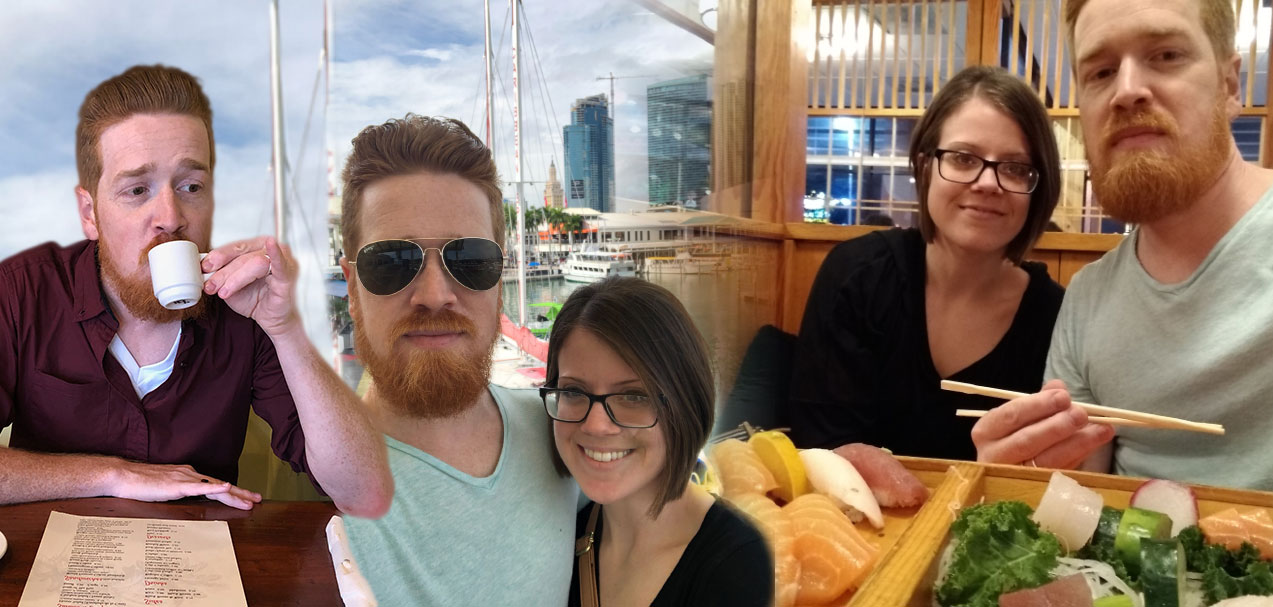
For the last 30+ years, my father’s companies have been involved in the cruise ship tourism industry. During that time, he’s gained a fair amount of insight into what makes them tick. He’s developed and maintained professional relationships and personal friendships with many cruise line employees, and he’s seen assistant shore excursion managers work their way up the ladder to senior management. He’s maintained these relationships and addressed his business concerns through one-on-one interaction by traveling during the offseason to get in front of the cruise line decision makers. Only so much can be done over the phone or via email, neither of which plays to his strengths of identifying an opportunity and addressing it swiftly. I’ve had the pleasure of sitting in on many of my father’s meetings, dinners and dockside interactions ever since I was a child in St. Thomas, U.S.V.I., and this year the training wheels came off as he sent a team, rather than himself, to meet with some of the cruise lines based in Miami.
My wife and I, along with Bonnie Steinberg (you can get to know her here) and her husband arrived at Miami International the weekend prior to our Monday and Tuesday meetings to get over the jet lag of traveling from Alaska and Missouri, pad around Bayside Market for a day, and meet with each other to go over our information and game plan. We knew what we wanted to present to each cruise line, but even though I’d come up with an agenda and set of goals to accomplish with each group, the entire point of the trip seemed very nebulous to me.
“What are we trying to do down there?”, I asked my dad.
“I don’t know – whatever. We’re not really offering anything new, but every time I’ve made a trip to sit down with these folks, something has happened that made me glad I did. Get to know them, let them get to know you, and good things will happen.”, was his response.
I’m glad I made the trip. While I’ve been excited to work for my father and be a part of the team that he’s created, getting in front of our business partners has changed things for me indefinitely. I thought I had a clear idea, but never understood the passion that the people that are successful in this industry have for providing memorable experiences to their guests. I’m not talking just about Baranof; this website is replete with me expounding on the authentic, family, exclusive, etc. experiences we provide. I’m talking about the cruise lines. It blew my mind that out of the hundreds, if not thousands, of excursions that each one of these lines offer, the managers we met with knew in intimate detail every aspect of our little operation in Ketchikan, Alaska. I can’t overstate their commitment. Bonnie and I, along with our spouses and a cameo by guide Jeff Kraynik, spent an hour or more with each cruise line over the two days we were down there identifying what we do well and areas for improvement. These are busy people, and I was prepared to be ushered out after a courtesy meet and greet, but to a business, they were bringing in customer service specialists, shore excursion managers, inventory control directors – you name it. My point is this; while any business will tell you they work hard to provide a great customer experience, I can promise that every cruise line I’ve met with to date will offer only a great customer experience. They are large companies, which in my small-town mind would intuitively preclude them from offering the attention to detail that a mom-and-pop operation can. The converse is true here – with the backing only a multi-national business can provide, these groups have provided the resources and qualified personnel to ensure that each one of their thousands of guests is treated personably, respectfully, and as a valued customer.
I’ve been proud to find work at my father’s company and be a part of what he’s built. Since our trip to Miami, that pride now extends to this entire industry. While the goal of any company is to make money, I know that we’re blessed to be working with companies and individuals that enjoy their work for the service they provide. The successful people in this marketplace, as with any, are those passionate about what they do. In this industry, that translates to directors and managers as concerned about you checking bucket-list items off as you are, with a commitment you can’t demand with salary alone.
Now, if they could turn their attention to detail to the traffic situation in Miami, the world would be a truly remarkable place
From the Wheelhouse
Our captain’s report on up-to-date fishing conditions, regulations, and trends.
View Report
Check Back For These Great Upcoming Stories
- Overnight kayaking through the Mistys Fjords
Nothing breaks you into the beauties of the Misty's like a week paddling through her splendor. - SE Alaska 2019 Fishing Regulations
Fishing limits and the Fish & Game’s reasoning, and what it means for Baranof’s guests. - Adventure around Revillagigedo Island
Misty's, Hot Springs, Fishing, Crabbing, and wildlife; the experience of a lifetime.
- February 2024
- April 2023
- June 2022
- March 2021
- February 2021
- March 2020
- February 2020
- January 2020
- December 2019
- October 2019
- August 2019
- June 2019
- April 2019
- February 2019
- January 2019
- November 2018
- October 2018
- September 2018
- June 2018
- May 2018
- April 2018
- March 2018
- February 2018
- January 2018
- December 2017
- November 2017
- September 2017
- August 2017
- July 2017
- June 2017
- May 2017
- April 2017
- March 2017
- February 2017
- January 2017